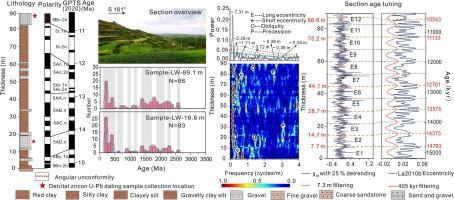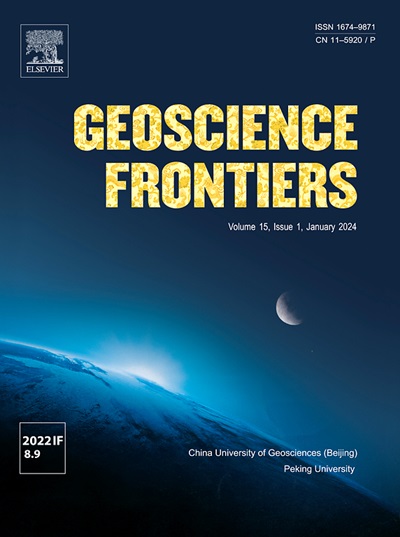Orbital forcing of Middle Miocene East Asian summer monsoon variability recorded by aeolian sediments on NE Tibetan Plateau
IF 8.9
1区 地球科学
Q1 GEOSCIENCES, MULTIDISCIPLINARY
引用次数: 0
Abstract
An accurate chrono-stratigraphy of aeolian sediments is crucial for understanding East Asian Summer Monsoon (EASM) variability. However, there are few studies of EASM variability recorded in aeolian sediments on the northeastern margin of the Tibetan Plateau, especially high-resolution aeolian sedimentary sequences spanning the period of 15–10 Ma. We studied an aeolian red clay section (89.1 m) with interbedded fluvial sediments, in the Jianzha Basin, northeastern Tibetan Plateau, using the integration of magneto stratigraphy, cyclo-stratigraphy, and detrital zircon provenance analysis. Magneto stratigraphy revealed 12 normal and 11 reverse polarity zones that are well correlated with chrons C5n.2n to C5Bn.2n of the Geomagnetic Polarity Time Scale (GPTS); this constrains the age of the section to the Middle Miocene. Subsequently, we use the frequency-dependent magnetic susceptibility as an EASM proxy, combined with spectral analysis in the depth domain, to identify Earth orbital periodicities. Gaussian band-pass filtering enabled us to extract the 405-kyr eccentricity signal, which provided a high-resolution astronomical time scale for the interval of 15.231–10.439 Ma. Detrital zircon U-Pb provenance tracing and sediment accumulation rate analysis revealed a provenance shift between 14.08 Ma and 10.2 Ma, which we attribute to the rapid uplift of the West Qinling Mountains at ∼ 13–12 Ma. The relationship between the variation of monsoon proxy indicators in the section and the global marine oxygen isotope (δ18O) record indicates that EASM evolution during the Middle Miocene was primarily a response to global temperature changes. On an orbital time scale, the frequency-dependent magnetic susceptibility record shows a significant long-eccentricity (∼405 kyr) periodicity component, indicating that EASM variations during the Middle Miocene were forced mainly by eccentricity. We conclude that a combination of eccentricity-modulated low-latitude summer insolation and Antarctic Ice Sheet fluctuations drove the eccentricity-paced precipitation variability on the northeastern Tibetan Plateau during the Middle Miocene.

准确的风成沉积物年代学对理解东亚夏季风(EASM)的变率至关重要。我们研究了一个风成红粘土剖面。磁地层学显示12个正极性带和11个逆极性带,与C5n年轮具有较好的相关性。20亿到50亿美元。地磁极性时间标度(GPTS)的2n;这就限定了该剖面的年代为中新世中期。随后,我们使用频率相关磁化率作为EASM代理,结合深度域的频谱分析来识别地球轨道的周期性。高斯带通滤波提取了405kyr的偏心率信号,提供了15.231 ~ 10.439 Ma区间的高分辨率天文时间尺度。碎屑锆石U-Pb物源示踪和沉积堆积速率分析显示,在14.08 ~ 10.2 Ma之间发生物源转移,这归因于西秦岭在~ 13 ~ 12 Ma的快速隆升。该剖面季风代用指标的变化与全球海洋氧同位素(δ18O)记录的关系表明,中中新世东亚季风演化主要是对全球温度变化的响应。在轨道时间尺度上,频率相关磁化率记录显示出明显的长偏心率(~ 405 kyr)周期分量,表明中中新世期间的东亚电磁振荡主要是由偏心率驱动的。
本文章由计算机程序翻译,如有差异,请以英文原文为准。
求助全文
约1分钟内获得全文
求助全文
来源期刊

Geoscience frontiers
Earth and Planetary Sciences-General Earth and Planetary Sciences
CiteScore
17.80
自引率
3.40%
发文量
147
审稿时长
35 days
期刊介绍:
Geoscience Frontiers (GSF) is the Journal of China University of Geosciences (Beijing) and Peking University. It publishes peer-reviewed research articles and reviews in interdisciplinary fields of Earth and Planetary Sciences. GSF covers various research areas including petrology and geochemistry, lithospheric architecture and mantle dynamics, global tectonics, economic geology and fuel exploration, geophysics, stratigraphy and paleontology, environmental and engineering geology, astrogeology, and the nexus of resources-energy-emissions-climate under Sustainable Development Goals. The journal aims to bridge innovative, provocative, and challenging concepts and models in these fields, providing insights on correlations and evolution.
 求助内容:
求助内容: 应助结果提醒方式:
应助结果提醒方式:


